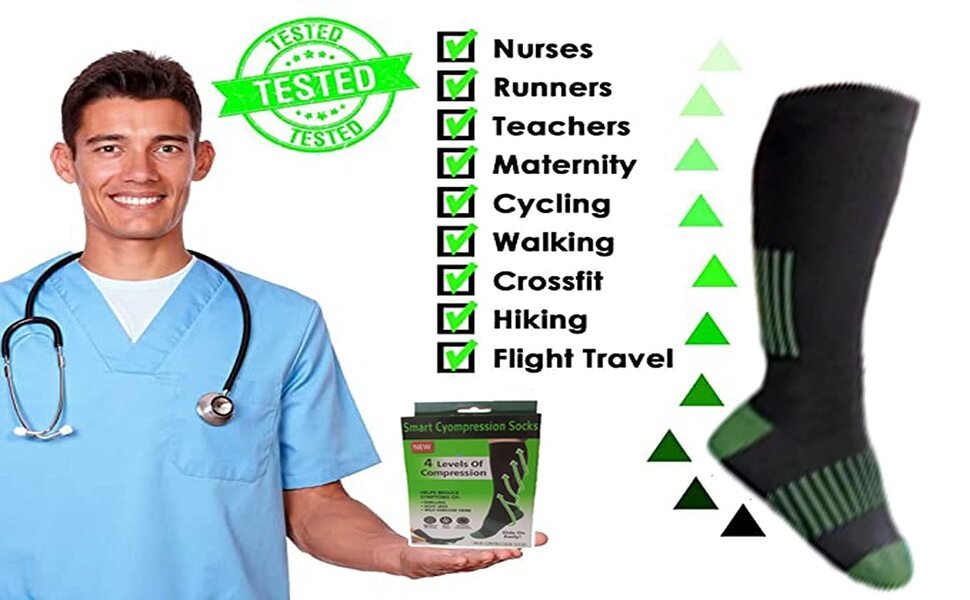Compression socks, once primarily associated with medical conditions, have evolved into versatile accessories valued for their ability to enhance circulation, reduce fatigue, and promote overall leg comfort. Whether worn during long flights, athletic activities, or as part of everyday wear, compression socks have gained popularity for their potential health benefits. In this article, we’ll explore the features of compression socks, their benefits, and how they have become an integral part of lifestyle and wellness.
Features of Compression Socks:
1. Graduated Compression:
The defining feature of compression socks is their graduated compression design. This means the compression is tighter at the ankle and gradually decreases as it moves up the leg. This design aids in promoting blood circulation and preventing fluid accumulation.
2. Elastic Materials:
Compression socks are typically made from elastic materials such as spandex, nylon, or a blend of synthetic fibers. These materials provide the necessary pressure to support blood flow while maintaining flexibility and comfort.
3. Various Compression Levels:
Compression socks come in different compression levels, typically measured in millimeters of mercury (mmHg). Common levels include mild (15-20 mmHg), moderate (20-30 mmHg), and firm (30-40 mmHg). The choice of compression level depends on individual needs and preferences.
4. Moisture-Wicking Fabric:
Many compression socks are made with moisture-wicking fabric to keep the feet dry and comfortable. This feature is particularly beneficial during athletic activities or when wearing compression socks for extended periods.
5. Seamless Construction:
To minimize irritation and enhance comfort, compression socks often feature seamless construction. This design reduces the likelihood of rubbing or chafing, making them suitable for all-day wear.
Benefits of Compression Socks:

1. Improved Blood Circulation:
The graduated compression of these socks helps improve blood circulation by assisting the veins in transporting blood back to the heart. This can be especially beneficial for individuals who experience leg swelling or venous issues.2. Reduced Swelling and Edema:
Compression socks can help reduce swelling and edema, particularly in the ankles and lower legs. The gentle pressure applied by the socks aids in preventing the accumulation of fluid in the tissues.
3. Prevention of Deep Vein Thrombosis (DVT):
Compression socks are commonly recommended for preventing deep vein thrombosis during long flights or periods of immobility. The compression helps maintain blood flow and reduces the risk of blood clots.
4. Alleviation of Leg Fatigue:
Individuals who spend prolonged hours on their feet, whether standing or sitting, can benefit from compression socks to alleviate leg fatigue. The improved circulation supports muscle oxygenation and reduces discomfort.
5. Muscle Support During Exercise:
Athletes often use compression socks to provide additional support to muscles during exercise. This can contribute to reduced muscle vibration, improved proprioception, and enhanced performance.
6. Post-Exercise Recovery:
Wearing compression socks post-exercise aids in muscle recovery by promoting efficient removal of metabolic waste products and reducing inflammation. This can contribute to a faster recovery process.
7. Temperature Regulation:
The moisture-wicking properties of compression socks help regulate temperature by keeping the feet dry. This is particularly advantageous in preventing discomfort and potential skin issues associated with moisture.
Common Uses and Considerations:
1. Travel and Long Periods of Sitting:
Compression socks are frequently recommended for long flights or extended periods of sitting. They can assist in preventing blood pooling, DVT, and swelling associated with prolonged immobility.
2. Work and Standing Professions:
Individuals with professions that involve prolonged standing, such as healthcare workers or retail employees, can benefit from compression socks to reduce leg fatigue and discomfort.
3. Athletic Activities:
Compression socks are popular among athletes for various sports, including running, cycling, and weightlifting. They provide muscle support, reduce muscle soreness, and contribute to overall performance.
4. Pregnancy:
Pregnant women may use compression socks to alleviate leg swelling and discomfort associated with increased pressure on the veins. However, it’s essential to consult with a healthcare professional for personalized advice.
5. Medical Conditions:
Compression socks are commonly prescribed for individuals with medical conditions such as venous insufficiency, varicose veins, or lymphedema. The level of compression and usage should be tailored to individual needs.
Safety Considerations:
1. Consultation with Healthcare Professionals:
Individuals with pre-existing medical conditions, such as diabetes or peripheral arterial disease, should consult with a healthcare professional before using compression socks to ensure they are appropriate for their specific situation.
2. Proper Sizing:
It’s crucial to choose the correct size and compression level for optimal effectiveness. Ill-fitting compression socks may not provide the desired benefits and could potentially cause discomfort.
3. Regular Monitoring:
Regularly monitor the condition of compression socks for signs of wear, stretching, or loss of elasticity. Replacing them as needed ensures continued effectiveness.
4. Avoiding Excessive Tightness
While compression is essential, excessive tightness can lead to discomfort, restricted blood flow, or skin irritation. Follow guidelines on proper fit and compression levels.
5. Gradual Adaptation:
If new to wearing compression socks, allow time for gradual adaptation. Start with shorter durations and gradually
increase wear time as comfort and tolerance improve.
Conclusion:
Compression socks have transcended their initial medical applications to become versatile tools for enhancing circulation, reducing fatigue, and promoting overall leg comfort. Whether worn during travel, athletic pursuits, or daily activities, these socks offer a proactive approach to maintaining optimal leg health. As individuals increasingly prioritize well-being and seek solutions for the challenges of modern lifestyles, compression socks stand as valuable allies in promoting leg health and comfort.




![Snapchat Spectacles (5th Gen) [Top Features Unveiled] [2024] Snapchat Spectacles](https://barefootclimb.com/wp-content/uploads/2024/10/Snapchat-Spectacles-150x150.jpg)






